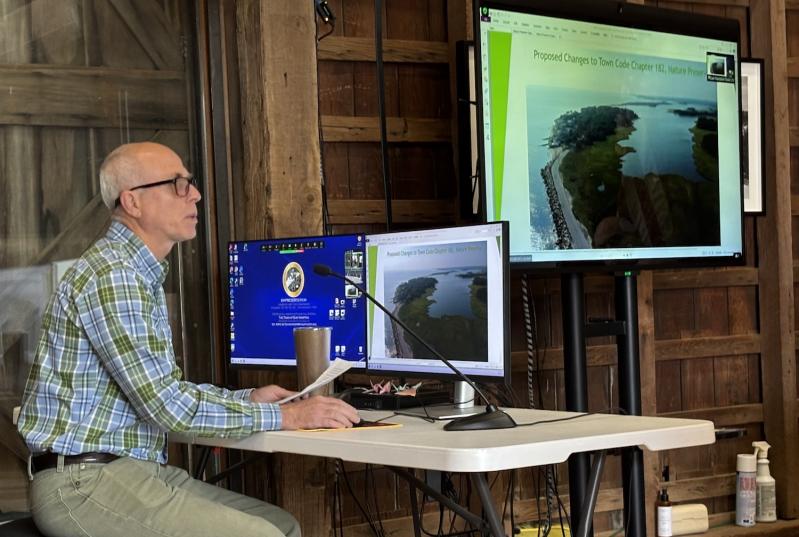A public hearing held by the East Hampton Town Board last Thursday about a community preservation fund acquisition at 351 Old Stone Highway in Springs highlighted the need for a subsequent discussion about changes to the town code regarding nature preserves, which came at Tuesday’s work session.
The nature preserve legislation was written in 1991, before creation of the community preservation fund or even the town’s Land Acquisition and Management Department, which plays a large role in managing nature preserves and other properties purchased with the C.P.F.
“The code is antiquated,” Councilman David Lys said at Tuesday’s meeting.
While the 5.4-acre parcel won’t necessarily be designated a nature preserve, the restrictions place on properties acquired with the fund often mirror those on nature preserves.
The lot is adjacent to other protected areas. It’s across the street or adjacent to the harbor protection overlay district, the Accabonac Harbor significant coastal fish and wildlife habitat, a critical environmental area, the Peconic Estuary Program critical natural resources area, a scenic area of statewide significance, and tidal wetlands.
Extensive freshwater wetlands flow through the property and into Accabonac Harbor. If the board approves the purchase, it would be for $1.75 million.
“This is a property I’ve been trying to acquire since I first started here in January of 2006,” Scott Wilson, the director of the Land Acquisition and Management Department, told the board at the hearing last Thursday.
“If it was an isolated piece, it would still be important to preserve,” he said by phone on Tuesday. “Contiguity makes it even more important. That way we preserve stretches of habitat and the species that depend on them.”
Indeed, one proposed code change discussed Tuesday highlights the importance of preserving contiguous lands, by embedding it on the list of desired traits in a nature preserve.
Other code changes would affect the nature preserve committee, which would still be appointed annually by the town board but would shrink from 10 members to seven.
“This is a direct reflection of how hard it is to get volunteers,” Mr. Wilson told the board Tuesday. He reasoned it will be easier to reach a voting quorum with the reduced number of committee members.
The committee is tasked with evaluating the suitability of parcels to be included in the town’s nature preserve inventory. It uses nine criteria, including quality of habitat for rare species, whether the parcel contains wetlands or ponds, if it provides examples of the effects of glaciation upon the landscape, whether it protects the watershed, or simply, “exemplifies wilderness.” Nominations are then referred to the Land Acquisition or Planning Department for a written analysis, which is subsequently presented to the town board.
The proposed legislation also would have the committee picking up an added responsibility: “advising the town board of enforcement and management problems.”
When a parcel is protected by the town it is governed by a generic management plan until a site-specific management plan is developed. Updates to the generic plan were also included in the proposed legislation. The most obvious change is language stating that “The Land Acquisition and Management Department will monitor and manage all nature preserves.”
Another change included “habitat restoration or revegetation activities,” without need for a specific management plan, and language pertaining to periodic mowing and grassland management, perhaps a nod to the town’s experiences with invasive vegetation infestations at town-owned properties in recent years.
In fact, Councilman Tom Flight wondered, since invasives were an issue across most of the town’s properties, if their control shouldn’t be included in the generic management plan.
While the legislation would remove references to jail time for prosecuted misdemeanors on town land (“I don’t think there’s ever been a situation where somebody was actually given a jail term,” said John Jilnicki, an assistant town attorney), Councilwoman Cate Rogers supported increasing monetary punishments. “If someone knowingly takes down a thousand square foot of nature preserve trees that have been there for decades to improve their view or something, then I think that. . . “
“. . . penalty is more than $350 bucks,” said Councilman David Lys, finishing her sentence. The board agreed that maximum fines should be increased and discussed with the town attorneys.
Finally, the board pondered limiting the use of eBikes on nature preserves, but legislating them poses challenges.
“We don’t want to limit an individual’s recreation on trails,” said Mr. Lys, “but we don’t want to provide avenues for vehicles.”
“You don’t want someone speeding through the trail,” said Ms. Rogers.
The legislation was not ready to be moved to a public hearing. Mr. Jilnicki agreed to take the board’s comments into consideration and to tweak it further, before bringing it back for a second discussion.




